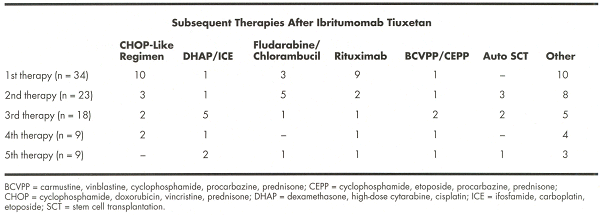Subsequent Chemotherapy Regimens Well Tolerated After Radioimmunotherapy With Ibritumomab Tiuxetan for Non-Hodgkin’s Lymphoma
Yttrium-90 ibritumomab tiuxetan (Zevalin) has been shown to be an effective and well-tolerated therapy for patients with relapsed B-cell non-Hodgkin’s lymphoma (NHL), with a response rate significantly higher than that seen with rituximab (Rituxan).
Yttrium-90 ibritumomab tiuxetan (Zevalin) has been shown to be an effectiveand well-tolerated therapy for patients with relapsed B-cell non-Hodgkin’slymphoma (NHL), with a response rate significantly higher than that seen withrituximab (Rituxan). The predominant toxicity of ibritumomab tiuxetan has beenreversible myelosuppression; five cases of myelodysplastic syndrome have beenreported in a total of 349 patients who have received ibritumomab tiuxetan. Dueto the bone marrow suppression seen with ibritumomab tiuxetan, concern has beenexpressed about the tolerability of further therapy at the time of progressionafter ibritumomab tiuxetan therapy.
The goal of this retrospective analysis was to evaluate what treatments wereadministered to patients who relapsed after ibritumomab tiuxetan therapy and toassess how well these therapies were tolerated. A total of 54 patients weretreated at the Mayo Clinic on three separate protocols that utilized ibritumomabtiuxetan at 0.4 mCi/kg. The median number of therapies prior to ibritumomabtiuxetan was 2 (range: 1-7). Two patients developed myelodysplastic syndromeand 35 patients have progressed after ibritumomab tiuxetan therapy. One patientdied before subsequent therapy was started, while 34 patients received otherchemotherapy regimens. The median number of subsequent therapies was 3 (range: 1-7).The number of patients receiving subsequent therapies after ibritumomab tiuxetanis shown in the table below:

Six patients were treated with an autologous stem cell transplant. Five hadperipheral blood stem cells successfully collected after ibritumomab tiuxetantherapy utilizing growth factor mobilization. One patient required a bone marrowharvest due to inadequate peripheral blood stem cell mobilization. Oneadditional patient had an allogeneic transplant. All patients regained adequateblood counts after transplantation.
Thirteen of the 34 patients required growth factor support with subsequentchemotherapy (other than the conditioning regimen for stem celltransplantation). However, only 1 patient had a 25% dose reduction at the startof the subsequent treatment regimen due to low counts after previous ibritumomabtiuxetan. Aside from those hospitalized at the time of transplantation, 10patients were hospitalized at some point due to neutropenic fever and/orthrombocytopenia. One patient died of infectious complications after the thirdchemotherapy regimen given after ibritumomab tiuxetan.
CONCLUSION: We conclude that chemotherapy or autologous stem cell harvest andtransplantation after prior therapy with ibritumomab tiuxetan is feasible andreasonably well tolerated. Patients may require growth factor support orpossibly dose modification with subsequent therapies. It is not known, however,if the tolerability of subsequent chemotherapy after ibritumomab tiuxetan isdifferent than that seen in similar patients treated with other salvagechemotherapy regimens.